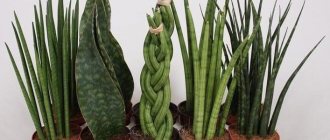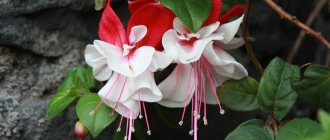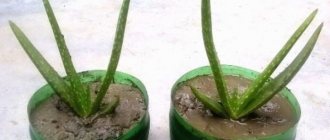Description of Sansevieria
“Pike tail” is one of the common names of the plant. Others are “snake skin”, “mother-in-law’s tongue” and “wolf tail”.
Sansevieria received its scientific name in honor of the Prince of San Severo Raimondo di Sangro, who lived in the 18th century and invented color printing and many other useful things.
The flower was brought to Europe from Southeast Asia and from the shores of the African country of Congo. The number of plants belonging to the genus Sansevieria exceeds 50.
The secret to the popularity of the pike tail is simple - incredible beauty combined with ease of care. A distinctive feature of this perennial succulent is its striped, smooth, dark green leaves that grow from the very roots and reach 1 m in height. White or yellow patterns can be located both along the leaf plate and across it.
There is often a sharp tip at the top of the leaf. Despite the possible inconvenience, you should not break off the thorn under any circumstances, as this will slow down the growth of the plant. With its shape, the sheet can resemble a saber, a pencil, and even a spoon.
With proper care at home and sufficient lighting, Sansevieria begins to bloom. This usually happens in the spring, when a peduncle with small and white buds emanating the aroma of vanilla appears from a rosette of leaves.
In the interior of an office or home living room, it looks good in composition with other indoor plants. An excellent option is several plants planted in a row in a long and low pot.
Pike tail flower: harm or benefit
But this is not the only benefit of the “pike flower”: it has long been recognized as a medicinal plant, even if it is not as famous in this matter as milk thistle, calamus or chamomile. The range of uses of sansevieria in natural medicine is very wide: it is recommended as a choleretic and diuretic, crushed roots are actively used as an antiviral, diaphoretic and immune-strengthening, and are also used in the treatment of bronchitis, dry cough, fungal diseases of the skin and even inflammation of the reproductive system in women. There are even cases of elimination of ulcerative and other inflammations on the skin, acne, and purulent wounds. Like plantain, a leaf of “pike tongue” can be applied to a cleaned wound, after first kneading it in your hands until the juice is released, and the next day the damage will begin to heal.
Like any plant, sansevieria purifies the air through oxygen exchange, and also neutralizes harm from computer and other radiation, as a result of which the flower pot is often placed near electrical appliances. But it is also credited with several interesting properties that are difficult to explain from the point of view of natural science. Firstly, it is believed that where the “pike tail” lives, scandals and disputes quickly fade away, and minor squabbles do not develop into a serious quarrel. Secondly, it increases self-confidence in those who are often near the plant, allows them to develop independence from the opinions of others, and even improves male potency. Thirdly, it weakens the influence of atmospheric fluctuations and magnetic storms on the body, and also prevents viruses from multiplying indoors (this applies to carriers of ARVI). And most importantly, sansevieria is considered an excellent assistant for those who are plagued by constant stress, mood swings, fatigue and decreased concentration, since the flower affects the nervous system and brain function.
The last point can be explained by the fact that the “pike tail” contains essential oils in the chemical composition of its leaves, which have long been widely used in aromatherapy. Indeed, these vapors can have a positive effect on the nervous system, relieving difficulty breathing, relieving tension and headaches from spasms, and improving mood. However, how noticeable all this will be in the usual “neighborhood” of a flower in an apartment is difficult to say with certainty. Experts say that sansevieria in this case will rather work as a general tonic, providing light protection, but not being able to eliminate the problem as quickly as aromatherapy directly with the essential oil of this plant.
But if a huge share of the benefits of the flower have been proven and confirmed by comments and reviews of ordinary consumers, then the harm from the “pike tail” flower consists only of a bunch of signs, practically not supported by real facts. For example, it is believed that if sansevieria suddenly blooms in winter, there will be family discord. As for the real disadvantages of the plant, neither botanists nor the owners of the “pike tail” have identified them. On the contrary, it is sometimes called an “oxygen factory” and a “filter”, which actively purifies the air from harmful impurities, as a result of which you can find sansevieria not only in ordinary apartments, but also in public places, including those where there are many children: schools, kindergartens , hospitals, etc.
The benefits and harms of sansevieria
The pike tail is loved because it perfectly purifies the air. According to NASA research, this flower has the rare property of absorbing carbon dioxide and other substances released from plastic.
Before placing a plant in a child's room, you need to make sure that children or pets will not taste it. The fact is that some varieties, which are completely safe in contact with skin, cause nausea and vomiting when ingested.
In folk medicine, pike tail is used to treat open wounds, burns and inflammations.
It is used in the same way as aloe: pieces of leaves are applied to damaged areas of the skin.
Pests and diseases
Sansevierias are practically not susceptible to diseases. It is only necessary to avoid excessive watering and, therefore, waterlogging of the soil, since this will cause the plant to rot, and low temperatures. If the plant is partially affected, it is reanimated by removing the affected parts and replanting it on a new substrate. After this, the plant should remain dry and in a warm place.
— Pests in practice are scale insects and mealybugs; they can come from other infected plants. We regularly inspect the plant for pests and carry out treatment in a timely manner.
- Diseases are mainly associated with excess moisture, as mentioned above - root rotting. Care should be taken to ensure good drainage and proper watering.
Pike tail (sansevieria): varieties
Varieties of Sansevieria differ significantly from each other in their appearance: leaf shape, color of stripes and size - from a giant cylinder to a small Hunny. In order not to get lost among such diversity, you should familiarize yourself with the most common of them.
Sansevieria three-striped, the same one that is called the “pike tail”, has dark green leaves lined with transverse light stripes. The height of the leaves reaches 120 cm, and their width is 10 cm. The green edges of the leaf, tapering towards the top, form a spike.
Sansevieria three-lane
Sansevieria cylindrica (cylindrica) received its name due to its thick paired leaves. Color – gray-green with transverse dark stripes. The largest specimens grow up to two meters in height.
Sansevieria cylindrica (cylindrica)
Sansevieria Twister is more of a forming method than a variety. The leaves of young plants are braided in the form of a braid. The length of this “hairstyle” ranges from 30 cm to 1 m.
Sansevieria Twister
Sansevieria Laurenti is a variety that has become the “parent” of many other species. The main feature is the contrasting yellow edges. The color of the long leaves is heterogeneous - dark stripes alternate with light ones.
Sansevieria Laurenti
Sansevieria Hanni (low-growing) differs from the previous ones in short dark green leaves, bent in different directions. It has a very modest size - no more than 30 cm. This type of pike tail was patented relatively recently, in 1941, by a scientist named S. Khan.
Sansevieria Hanni (low growing)
Sansevieria Golden Honey was patented a little later, in 1953. In appearance it resembles the Hanni variety, but the color is slightly different - the edges of the leaves are decorated with yellow stripes.
Sansevieria Golden Honey
Sansevieria Silver Hanni is another derivative of Hanni. Identical in rosette shape, but the leaf has silver veins and a dark edge.
Sansevieria Silver Honey
Sansevieria zeylanica is famous for its spectacular appearance, despite its medium size (30-150 cm). Characteristics: wide leaves with silver wavy stripes and specks. Some botanists classify Zeylanica as a variety of Sansevieria three-lane.
Sansevieria zeilanica
Sansevieria Silver Queen is a variety of piketail with matte silver leaves. The pattern on the plate is practically not expressed, there is only a thin dark edging. It is considered fast growing, but does not bloom.
Sansevieria Silver Queen
Sansevieria Black Dragon is a rare variety with glossy dark, almost black foliage. The maximum height of the flower is no more than 25 cm. The leaf shape is oval, with pointed ends and a spike at the end.
Sansevieria Black Dragon
Sansevieria Futura is a low-growing but noticeable variety. The leaf length does not exceed 30 cm. The bright, rich color of the leaves with longitudinal yellow stripes and dark specks always attracts attention.
Sansevieria Futura
Sansevieria Moonshine is a new addition to the piketail family. Outwardly, with its gray-green uniformity, it resembles Silver Queen, but differs in the length of the leaf (no more than 35 cm).
Sansevieria Moonshine
Sansevieria bonselensis is an exotic specimen with thick, voluminous leaves arranged in a fan. Height – 10-30 cm. The color indicates its relationship with the cylinder.
Sansevieria bonselensis
Sansevieria gold flame. If in most varieties the yellow stripes are located along the edges of the leaf and serve as an edging, then in these “tails” they occupy a good half of the leaf. The sizes are average - about 30 cm.
Sansevieria gold flame
Quarreling
According to signs, Sansevieria absorbs the energy of the inhabitants of the house, which can lead to quarrels between household members.
Its leaves are like long antennas that absorb negative manifestations of emotions: rudeness, anger, bad mood, apathy. In order not to spoil the energy, it is better to start “mother-in-law’s tongue” in large rooms.
If you properly care for the plant, its negative influence can be neutralized and turned into a talisman. Then the flower will protect family members from gossipers and liars, help them concentrate and calm them down.
Home care
Pike tail is one of the most undemanding plants to care for. To make a flower comfortable, you only need to know the basic rules.
One of them is that Sansevieria does not like to be moved from place to place.
Lighting
Sansevieria feels equally good both in a sunny corner and in a shaded one.
But it should be remembered that in the absence of light for a long time, variegated varieties lose their brightness.
It is better to protect the plant from direct rays, as this can cause burns. In winter, artificial supplementary lighting is recommended. In spring and summer, the pike tail can be taken out into the fresh air, but the place is chosen in such a way that raindrops do not fall on the leaves.
Temperature
The flower is completely indifferent to temperature changes; not a single draft will harm sansevieria. In summer, the optimal thermal regime is from +18° to +25°С, in winter +14…+16°С. At air temperatures below +10°, the plant will not die, but will stop growing.
Watering
Like other succulents, it does not tolerate excess moisture. It is enough to water the pike tail once a week in the summer and once a month in the winter. An important point is that you need to carefully ensure that water does not get into the middle of the outlet, as this will lead to rotting.
Top dressing
Even the most unpretentious herbal pets need vitamins, and therefore we must not forget about fertilizers. They feed the mother-in-law's tongue three times during the summer (once a month). At the same time, a 50% solution of mineral fertilizer for cacti is added (with a predominance of the potassium-phosphorus component).
Transplantation and soil
Since the root system of the pike tail does not grow in depth, but to the sides, the pot must be wide and strong enough to withstand the pressure.
It is imperative to make a drainage layer. The ideal soil consists of leaf, turf soil and sand in a ratio of 2:2:1. Young plants are usually replanted once every one and a half to two years, older plants - once every three years. If the procedure is carried out in the spring, then it is combined with dividing the bush.
Description and characteristics
What does a pike tail (mother-in-law's tongue) look like?
Bloom. Some types of mother-in-law's tongue bloom in the warm seasons of the year if you care for them properly. The flowers are of little use for decorative purposes: they are small, inconspicuous, with greenish-white narrow petals.
The flowers are collected in an inflorescence. It has a cylindrical shape and a long, straight-growing peduncle. The flowers open at 6 pm, revealing long stamens, at night they give off a strong vanilla-clove scent, and in the morning the petals close again.
Leaves. Green, with shades of brown, silver or yellow, spotted or striped (depending on the species), they can be more than a meter long, each leaf ends with a point.
The leaves have a thin layer of a wax-like substance. This substance protects the mother-in-law's tongue from loss of moisture, which is very important for the desert climate. Leaves grow vertically or sideways. The leaves at the roots are especially hard.
Stem . The plant is stemless.
Rhizome. It is located underground, creeping, its rhizomes develop strongly and can tear the container in which the pike tail is planted.
We have an interesting article that will tell you about caring for your home plant Sanvieria.
Reproduction methods
There are several ways to obtain new specimens of Sansevieria.
Side shoots
With this method, the shoot is separated from the parent plant. To do this, the rhizome that connects the baby to the “mother” is cut with a knife. The cut area is sprinkled with crushed coal, then planted in a separate container with fresh soil. You need to handle the newcomer with care: when watering, avoid getting liquid on the leaves, and also do not feed.
Leaf
For such propagation, old lower and healthy leaves are taken. They are cut into pieces of 5-10 cm and left for a couple of days at room temperature. After such drying, the cuttings are planted vertically in damp sand or peat to a depth of 2 cm. It is very important here not to confuse the top and bottom of the piece, because if planted on the wrong side, the roots will not grow. The distance between young tails is 2-4 cm.
The top of the “bed” is covered with cans or plastic bags, which must be removed once a day to provide ventilation for the cuttings. Water as needed through a tray. Two to three months later, after the roots and stems appear, the plants are picked. This method is only suitable for varieties with green leaves; variegated stripes are not inherited in this way.
Dividing the rhizome
By dividing the rhizome, adult specimens with a developed root system are propagated. It is necessary to divide the rhizome so that each piece contains at least one bud. The sections are treated with fungicide or crushed coal, then planted in the ground.
How to propagate
— Reproduction of Sansevieria is not difficult. The easiest and most popular way to propagate sansevieria is by dividing the plants during transplantation. During the process of growth, plants form daughter shoots, rosettes, which are also used for propagation. In this case, rosettes with already developed roots are separated from the main mother plant and planted in a mixture for adult plants. The pots are placed in a bright place and watered with a small amount of water until rooting is complete. Sansevieria, the propagation of which does not take much effort and time.
When taking leaf cuttings, the leaf is cut into pieces 10 cm long, placed two-thirds of the length in sand, covered with a jar and kept in a warm and bright place. The plant is ventilated daily and the level of rooting is checked by lifting the jar. Watering is carried out in the tray of the pot. This rooting method takes quite a long time, 1-1.5 months: first the roots develop, then the buds, and young leaves appear from the roots.











